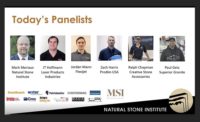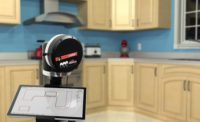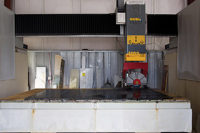Recently Stone World had the opportunity to talk to the vice president of ETemplate Systems, Ted Allen, to discuss all things digital templating. The first thing discussed was one of the most commonly asked questions, where do you start as a fabricator? With a CNC? With a templating machine or something else?
“Well, we've seen several fabricators do this, and we've worked with a variety that have done it as well,” said Allen. “Some choose to go with vinyl templates and use a template cutter. That way, they can start using a templating device from us. One of our systems, either our pro or express system. Both of those are systems that they can go out, create their templates, and then print those on 10 mil thick vinyl, and be able to lay those out on the stone, even if they are not cutting with, say, CNC equipment at this time. They can still use a bridge saw they can get wet and it doesn't destroy the template. That process works really well as a transitional product for going to full automation with CNC, your DXF files going straight to the machinery.”
One of the concerns that is heard a lot with digital templating, or any new machine, is how long does it takes to learn, is it difficult to learn, is it going to require new people, etc.
“We've had other companies out there that were somewhat intimidated,” said Allen. “Because whenever you look at technology and computers and all these things sometimes they're a little intimidated by that, but they found that it's very, very easy to use. The training process kinda does everything for the client to help them understand how to use it. And then the software having more automated features and functions, our measure manager software specifically, automates a lot of that process. So the user doesn't have to be a CAD wizard or a guru on computers or anything like that. They just need to understand how it works, and be able to repeat the process, and they can be very successful.”
The other question that is usually asked by fabricators is why should they even switch to begin with? Things in their shop work fine as is, so why make the change?
“Well, it's a matter of efficiency,” said Allen. “It's how many jobs you can get done. If you're doing stick templates, you're creating those in the field, and you gotta transport them back to the office. We hear stories about them falling apart. You know, problematic situations with stick template something not particularly being templated the way they want to. By the time it gets back to the shop it's worked, or something like that. And it takes time. That whole process takes time, not just the templating itself, but getting it back to the shop, laying it out, cutting it and then installing it. So if you're trying to increase efficiencies, it is a lot easier to be able to shoot and create a digital template with us and email that file back to the office. So your Templar can leave that job that they were just on, go to the next job and not have to take a template back to the shop. So while they're templating, you can be cutting, and that's efficiency. So anytime you can cut, sell and install more jobs in a day, you're gonna make more money. You're gonna be more profitable and you're gonna be more efficient.”




